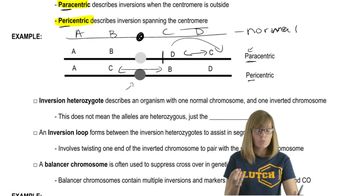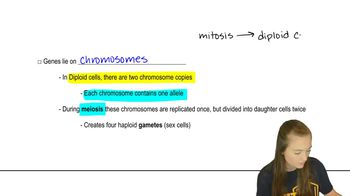A couple planning their family are aware that through the past three generations on the husband's side a substantial number of stillbirths have occurred and several malformed babies were born who died early in childhood. The wife has studied genetics and urges her husband to visit a genetic counseling clinic, where a complete karyotype-banding analysis is performed. Although the tests show that he has a normal complement of 46 chromosomes, banding analysis reveals that one member of the chromosome 1 pair (in group A) contains an inversion covering 70 percent of its length. The homolog of chromosome 1 and all other chromosomes show the normal banding sequence. Would you advise the woman that she will have to bring each pregnancy to term to determine whether the fetus is normal? If not, what else can you suggest?
Table of contents
- 1. Introduction to Genetics51m
- 2. Mendel's Laws of Inheritance3h 37m
- 3. Extensions to Mendelian Inheritance2h 41m
- 4. Genetic Mapping and Linkage2h 28m
- 5. Genetics of Bacteria and Viruses1h 21m
- 6. Chromosomal Variation1h 48m
- 7. DNA and Chromosome Structure56m
- 8. DNA Replication1h 10m
- 9. Mitosis and Meiosis1h 34m
- 10. Transcription1h 0m
- 11. Translation58m
- 12. Gene Regulation in Prokaryotes1h 19m
- 13. Gene Regulation in Eukaryotes44m
- 14. Genetic Control of Development44m
- 15. Genomes and Genomics1h 50m
- 16. Transposable Elements47m
- 17. Mutation, Repair, and Recombination1h 6m
- 18. Molecular Genetic Tools19m
- 19. Cancer Genetics29m
- 20. Quantitative Genetics1h 26m
- 21. Population Genetics50m
- 22. Evolutionary Genetics29m
6. Chromosomal Variation
Chromosomal Rearrangements: Inversions
Problem 12d
Textbook Question
A pair of homologous chromosomes in Drosophila has the following content (single letters represent genes):
Chromosome 1RNMDHBGKWU
Chromosome 2RNMDHBDHBGKWU
How does the pairing diagrammed in part (b) differ from the pairing of chromosomes in an inversion heterozygote?
 Verified step by step guidance
Verified step by step guidance1
Examine the given chromosome sequences: Chromosome 1 (RNMDHBGKWU) and Chromosome 2 (RNMDHBDHBGKWU). Note that Chromosome 2 contains a duplication of the segment 'DHBG'.
Understand the concept of an inversion heterozygote: In an inversion heterozygote, one homologous chromosome contains a segment that has been inverted (flipped in orientation) compared to the other homologous chromosome.
Compare the given pairing to an inversion heterozygote: In the given pairing, the difference is due to a duplication of a segment ('DHBG') in Chromosome 2, not an inversion. In an inversion heterozygote, the homologous chromosomes would align with a loop structure to accommodate the inverted segment.
Describe the structural difference: In the given pairing, the chromosomes align without forming a loop because the difference is a duplication, not an inversion. In contrast, an inversion heterozygote would require a loop to align the inverted segment with its homologous counterpart.
Conclude the comparison: The pairing in the given problem differs from an inversion heterozygote because it involves a duplication rather than an inversion. The structural adjustment (loop formation) seen in inversion heterozygotes is not necessary here.
 Verified video answer for a similar problem:
Verified video answer for a similar problem:This video solution was recommended by our tutors as helpful for the problem above
Video duration:
2mPlay a video:
Was this helpful?
Key Concepts
Here are the essential concepts you must grasp in order to answer the question correctly.
Homologous Chromosomes
Homologous chromosomes are pairs of chromosomes in a diploid organism that have the same genes at the same loci but may carry different alleles. In Drosophila, these chromosomes can undergo various structural changes, including inversions, which can affect gene expression and pairing during meiosis.
Recommended video:
Guided course

Chromosome Structure
Inversion Heterozygote
An inversion heterozygote is an individual that has one normal chromosome and one chromosome with a segment inverted. This structural alteration can disrupt normal pairing during meiosis, leading to potential issues in gamete formation, such as the production of unbalanced gametes due to improper crossing over.
Recommended video:
Guided course

Inversions
Meiotic Pairing
Meiotic pairing refers to the alignment of homologous chromosomes during meiosis, which is crucial for accurate segregation of genetic material. In the presence of inversions, the pairing may be altered, leading to unique configurations that can affect genetic recombination and the viability of gametes.
Recommended video:
Guided course

Diploid Genetics
Related Videos
Related Practice
Textbook Question
380
views


